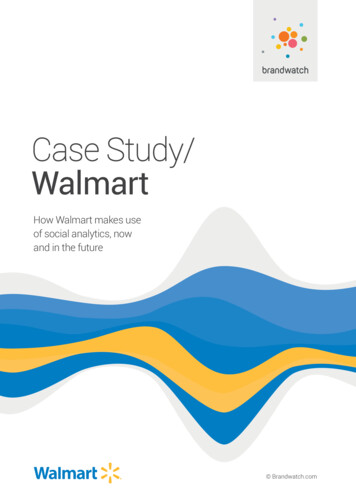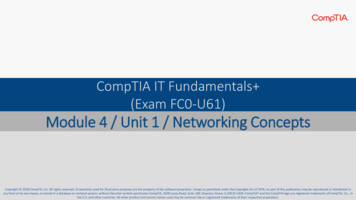
Transcription
The Fundamentals ofSocial Media Analytics
IntroductionTable of ContentsUnderstanding consumers and their preferences has always been essentialfor brands and agencies. In the past, the only way to accomplish this was torun a survey or a focus group or hire an outside market research firm.Today, things are different. There are now trillions of unsolicited consumerposts on social media that brands can track in real-time to better understandtheir target audience, industry landscape, brand perception and so muchmore.Introduction2Part 1: What is social media analytics?3Social media analytics vs social media monitoring vs social media intelligence4Understanding unsolicited conversations6Social media engagement6Part 2: Dealing with unstructured dataIn light of all this social data on consumer opinion, we come to a naturalquestion: How can marketers, strategists, executives and analysts extractmeaningful consumer insights from this data? Social media analytics providesthe solution to uncovering consumer insights from online data.Defining unstructured dataMachine-automated NLP and machine-learningPart 3: Uncovering consumer insights with social media analyticsThis guide aims to provide a framework for getting starting with social mediaanalysis. Whether you’re a CMO, an analyst, or a marketing manager, thisguide will help you learn the fundamentals of social media analytics and howyou can apply it to help your organization make smarter decisions backed byconsumer insights.91012Quantitative analysis: The what13Qualitative analysis: The why13Conclusion2715
Part One:What is social media analytics?Social media platforms—such as Facebook, Twitter,Instagram, and Reddit—are a public ‘worldwide forum forexpression’, where billions of people connect and sharetheir experiences, personal views, and opinions abouteverything from vacations to live events.But social media isn’t just a place for individualsto connect with each other. It’s also a place whereconsumers talk about brands, products, and theirpreferences. The growth of these platforms has providedcompanies a new source of insights on which to basetheir strategies: social conversations. Through socialmedia analytics, businesses have the opportunityto listen, monitor, and look in depth at theseconversations and understand what people aresaying online to make better-informed decisions.3
Social Media Analytics vs. Social MediaMonitoring vs. Social Media IntelligenceMany organizations don’t listen to social conversations because of theoverwhelming amount of available data; however, there are certain tools thatspecialize in capturing and interpreting this conversation online, making iteasier to separate valuable signals from social media noise. These tools cancrawl most social media channels, including anything from the main socialnetworks to forums, news sites, and blogs.Whether you are knowledgeable of these terms or not, you’ve probably heardthe term ‘social media analytics’ used interchangeably with ‘social medialistening’ and ‘social media intelligence’, but they aren’t exactly the same.First, we’ll begin by approaching the term ‘Social Media Analytics’.The Definition of ‘Social Media Analytics’Of all the definitions for ‘Social Media Analytics’, Gohfar F. Khan’s hit the nailon the head. In his Seven Layers of Social Media book, he defined social mediaanalytics as “the art and science of extracting valuable hidden insights fromvast amounts of semistructured and unstructured social media data toenable informed and insightful decision making”.Within organizations, different people and departments have uniqueresearch questions, therefore their reasons for analyzing social mediaplatforms and leveraging social insights differ. Some of the use cases include:Brand positioning assessment: What are people saying about my brand?Competitive research: How is my competitor doing? What are people sayingabout their product?Campaign planning and measurement: Was the new campaign effective?What was the conversation around the campaign?Audience interest and demographic understanding: Who is interested in myproduct? What are their interests?Industry and product trend discovery: What are popular trends at themoment?Performance benchmarking: How is my product positioned compared to mycompetitor’s?Early warning – crisis management: What issues can be identified? How canit be fixed?4
Social Media Monitoring (SMM)Social Media Intelligence (SMI)Often referred as ‘social media listening’, social media monitoring is theongoing process of tracking and gathering what the audience is saying onsocial media—a hashtag, a keyword, or other terms—about a brand or itscompetitors.Social media intelligence encompasses monitoring social media, collectingand analyzing the content, and using the resulting consumer insights toinform strategy. Basically, SMI uses both social media monitoring and analyticsto derive strategic solutions.As stated in The Future Place, monitoring can be active, such as searchingfor specific brand mentions, or passive, like tuning into an audience to learnabout their interests.Think of McDonald’s new campaign introducing their preservative-freechicken nuggets. Both McDonald’s and the agency responsible for their ad “ABetter Chicken McNugget” would rely on SMM to track surface-level metricsto measure their new campaign. These vanity metrics, such as numberof likes, shares, or retweets would be used to assess basic engagement andcampaign performance, without looking for deep understanding of the socialconversation around McNuggets and its context.As a summary, SMM consists of identifying and collecting useful data, with nomeans of categorizing or understanding it. The data gathered through SMMcould be useful, but no actionable insights can be derived at this listeningstage.5
Understanding unsolicited conversationsSocial media analytics vs. social media engagementSocial media analytics is an exercise in omniscience, not omnipotence. Beforewe begin drilling into why this is so important, here are the definitions for both:Social media engagement involves a two-way conversation; withengagement, there’s a ‘personal’ interaction between brands and their fans.Examples of social media engagement include interactions with customers,prospects, and influencers on social networks. When engaging withcustomers, brands can reach out to customers to remediate any issues theymight have found through social monitoring.Omniscience: knowing everything; having unlimited understanding orknowledgeOmnipotence: having complete or unlimited powerTherefore, social media analysis and social media engagement are not thesame. Ultimately, social media analysis is about listening, whereas socialmedia engagement is joining the conversation.Social media is a place where users can talk freely without having tofilter themselves. This is why social media analytics is omniscient and notomnipotent: it knows everything about a certain topic, but doesn’t need toparticipate or control these social conversations. What we mean when we say“omniscient SMA”, we refer to the analysis of unsolicited conversations onsocial media, without the intent of interfering or asking them to be part of atwo-way conversation. Social media analytics is used to observe and inform,not to engage.Even if brands know how social media analysis works, where should theystart? Next, we’ll explain how brands can use social media analytics to makesense of the vast amount of unstructured data on social networks, andeventually use it to their advantage.Think of it this way: Batman is omniscient and Superman is omnipotent.Although most organizations want to assimilate themselves to a God-likecharacter with unlimited power like Superman, Batman is more intelligent,relatable and versatile in his job.Organizations can’t control the social conversation because socialconversations around brands on social media are largely unsolicited.Unlike traditional focus groups, social media analysis extracts consumerinsights from unsolicited conversations without the added bias of directcontact. By listening and understanding from an outside perspective withouttrying to be part of the conversation, you get a more objective perspective.“Superman is too busysaving the world, soBatman needs to focus onstreet level crime.”Photo Credit: UXDesignThe ArtificePhoto Credit: Warner Bros6
Part Two:Dealing with unstructured dataWith the explosion of big data, there has been areciprocal explosion of companies trying to minevalue from the overwhelming amount of data outthere. When looking at the data that needs to beanalyzed, we can find two distinct types: structuredand unstructured data.We are all aware of structured data: purchases,transactions and electronic sign-ups, but whatis unstructured data? How is it different fromstructured data?7
What’s the difference between structured andunstructured data?Structured Data (Enterprise)Structured data refers to the kind of data that is organized and displayedin a database with rows and columns, making it straightforward to work with.Examples of this include sales figures, names, phone numbers, etc.Unstructured data lacks organization. Due to its variability and unidentifiableinternal structure, unstructured data cannot be analyzed by the conventionaltechnologies.A few examples of ‘unstructured data’ are: Social media posts Emails ImagesPhoto Credit: The Executive's Guide to Big Data & Apache Hadoop Product ReviewsWhen looking at social media posts, we see that most of the informationcan’t be segmented into fixed categories due to the complexity and variabilityof the content. Social media users write about different subjects, in varyingforms, making it hard to categorize them in a strict manner. Due to theincrease in popularity of social media channels, new analytics tools andprocesses were developed to understand and extract value from this boomof unstructured data.Unstructured Data (Social Media)8
But why bother to analyze this unstructured data?Machine-automated solutions aren’t enoughIt can yield deeper insights.Most analytics companies offer machine-automated features, but theproblem is that the results can be inaccurate and not pertinent to the subjectmatter. Although machine automation requires less setup time, it risksproviding irrelevant information to the user when analyzing conversations indifferent industries with particular dialects and slangs.Organizations in several industries are researching and investing intoolsto extract meaning from this data and drive strategic business decisions,something hard to get from limited structured data. The value ofunstructured data comes from the patterns and the meanings that can bederived from it. Examples include identifying issues, market trends, or overallcustomer sentiment towards a brand.An example where a dialect or slang could be a problem is when a wordsuch as ‘wicked’ is used in different contexts. Meaning “evil or morallywrong”, ‘wicked’ is widely identified as a word with a negative connotation,thus machine-automated processes would negatively categorize phraseswith this word. However, ‘wicked’ has a different meaning in the state ofMassachusetts; used as a positive word, it can mean “very” or “occasionallycool”, making the outcome of the analysis very inaccurate and irrelevant tothe search.Two available solutions for the analysis of unstructured data are machineautomated NLP (natural language processing) and machine-learning.Machine-Automated Natural Language Processing (NLP)and Machine-LearningNatural Language Processing is a branch of artificial intelligence that allowsa machine to understand the human ‘natural’ language. Therefore, themachine-automated solution tries to make sense of the data by processingstatements and categorizing them in a systematic way.wicked.Applications of NLP on social data can identify general sentiment abouta topic—either positive, neutral or negative—or it can even go as far asanalyzing the universal emotions through emotion analysis.Back to School Emotions: Volume of Posts (Emotion) from 8/4/16 to 8/24/16Joy (261k)Sadness (203k)Disgust (10k)Anger (37k)Surprise (245)Fear (49k)50k40kPosts30k20k10k04 5Aug 2016678910 11 12 13 14 15 16 17 18 19 20 21 22 239
On the other hand, for more comprehensive text analytics, there’s themachine-learning approach.To better understand this concept, think of the online recommendationsfrom Amazon; depending on your purchases, search history, your ratings,Wish List, the interests of other similar customers, and more examples ofwhat you’re interested in, it will try to find items more relevant to your search.Or even better, think of machine-learning as a Gmail filter. Fundamentally,filtering in Gmail is adding a label or tag to emails, so that it can count andgroup emails of the same kind together. If properly trained, Gmail’s Inboxclassifies emails into Topics like Social/Promotions/Updates etc. This modellooks for patterns in the content of every email—such as keywords, phrases,authors—and assigns it to the most pertinent category; it doesn’t follow predefined parameters.Machine-learning allows tools to analyze multiple variablessimultaneously, and reveal how they interconnect to form patterns.This option differs from machine-automated solutions in many ways; sincethe outcome will be more related to the question the user is trying to solve,machine-learning requires external knowledge and deep understanding ofthe conversation’s subject matter to train the tools appropriately. Althoughtraining some posts to define each custom category may take some time,it will help the analysis tools to identify robust patterns and provide morerelevant consumer insights.Photo Credit: Madmimi10
Machine-automated approach: T-Mobile exampleThe following visual contains the same data and timeframe used to analyzeT-Mobile’s basic sentiment around its customer service. The main differenceis that through machine-learning, you can create custom categories thatwill explain the reason behind the positive, neutral and negative sentiment,providing actionable solutions you can apply. Whether it is expensive plans,bad coverage, or insufficient customer service, organizations like T-Mobilecan use machine-learning to understand the ‘why’ behind the negativesentiment towards their brand and make better informed decisions in thefuture.In the following example, we can see the analysis of T-Mobile’s customerservice on Twitter in 2015. Through machine-learning NLP, social posts canbe categorized into general positive, neutral, and negative sentiment byidentifying the keywords.It’s useful to know whether customer service was overall positive or negative,but how can you extract more valuable, relevant insights from this data? Howcan you know why big part of the conversation is negative? This is wheremachine-learning comes in.T-Mobile Support: Volume of Posts Opinion and AnalysisPositiveCustomer Service/Thank You (15,658)Buzz Copy of T-Mobile Support: Volume of Posts (Basic Sentiment)Positive (46,669)Neutral (94,107)NeutralPlans/Pricing (14,240)Negative (86,586)General Positive (6,238)Devices (20,942)Network/Coverage (17,004)General Neutral (25,517)15kNegativeGeneral Negative (18,133)Devices/Shipping (25,240)Network/Coverage (31,998)Plans/Pricing (17,074)Customer Service (13,055)10k9k10k8kPosts7kPosts6k5k5k4k3k2k1k00Feb 2015Apr 2015Jun 2015Aug 2015Feb 2015Apr 2015Jun 2015Aug 2015Oct 2015Custom categories in machine-learning processes allow the analysis to bemore accurate and precise; some advantages include deeper nuance andmeaning dependent on the user’s subject matter expertise and businesscontext. With this solution, brands can uncover highly specific consumerinsights to help them make more strategic decisions.Oct 201511
Part Three:Uncovering consumer insightswith social media analyticsIn marketing, strategy, and tech, we hear a lot ofjargon around ‘measurement’ and the ‘softwarelandscape’. ‘Insights’ have become ubiquitous, withmany organizations and individuals using this termin many different ways.In previous publications, we’ve described howinsights come in many different forms. Whatare customers saying about your products andcompany? How about your competition? Who isyour target market, what do they care about, andhow do you reach them effectively? What trendsare affecting your industry and how should yourespond? These are relevant questions to thedecision-making of businesses, and they can beanswered through social media analytics. First, wewill go over the difference between quantitativeand qualitative analysis to better understand howyou can derive actionable insights from social data.12
Quantitative analysis: the whatQualitative analysis: the whySimilar to the infamous McNamara Fallacy, this analysis supports the theorythat “If you can’t measure it, it doesn’t exist” because it can’t be proven.Therefore, in quantitative analysis, the only data taken into account forstrategic decision-making is the data you can count.Qualitative analysis is less related to hard numbers, and moreto the meaning behind those numbers. So why did your company get1,000 likes? Did they like the product? Or was it the message? What aboutthe athlete that was sponsored? These intangibles provide knowledge andinsights that can help drive more effective and strategic solutions becausethey get to the heart of consumer preferences and behavior.This type of analysis is efficient and easy to gather and analyze because ofits simplicity and concrete nature. Since it doesn’t deal with complex data, itis more easily comprehended, and therefore, more ‘credible’ than insightsgained from qualitative research, as it provides numerical proof.Consequently, quantitative analysis disregards data that isn’t in the form ofeasily digestible numbers; therefore, if you can only understand a fractionof the available information, it isn’t comprehensive or insightful enough.In social media, if your Facebook campaign post has 1,000 likes, you getto know its “weight”. However, the 1000 likes don’t necessarily mean thatthe campaign was successful. From the perspective of social listening, it isimportant to understand the context and nuance; it is critical to understandthe underlying ‘why’ of the 1,000 likes to see if it’s something that thecompany wants to do again in the future.13
For the most comprehensive insights, a combination ofboth quantitative and qualitative analysis is idealIn a presentation about The Power of Social Data with Schireson consultancy,Jazz at Lincoln Center (JALC) was able to gain valuable insights about theiraudience. In the following visual, we see how JALC was able to understandthe main interests of their audience and compare this to those of theircompetitors. Knowing this information about their audience allowed JALCto carry on more informed campaigns and promote customer intimacy.JALC Affinities Findings vs TwitterBloggingNew York CityMSNBCClassical re posts thanTwitter overallLess posts thanTwitter rs NFLHiphopAlthough it is harder to work with qualitative data, it is necessary tomake sense of it since it provides deeper insights, as well as nuance andperspective that would be impossible to get from mere volumetrics. Theresults can give an understanding of the story behind the results of theanalysis of quantitative data. For example, with qualitative data, you can findpopular trends or even emotional sentiment around brands.Baseball FashionHealthBasketballWorld newsFinance BeautyNews and mediaScience and technologyESPNAdapted from Slide by INBOUNDVolumetrics only touch the surface of understanding; they are a numericalindication of user reaction, but if complemented with insights, businesses candiscern what’s happening in social and why. Although all these insights canbe derived from metrics, not all metrics can be insights.Understanding the basics of social media analytics is the first step toobtaining social media insights of strategic importance to organizations.As the data analytics industry grows throughout time, possessing basicknowledge about this topic will help you find the optimal solutions to socialdata analysis.14
ConclusionThe scope and volume of data from social media may seem too large and toounactionable. But, with the right tools, social media data can provide key insightsand inform big decisions.Start uncovering consumer insightsfrom social media data today with acustomized demo of Crimson Hexagon.This guide was created to help you understand what social media analytics entails.We started by outlining the different elements in social media analytics andclearing up general misconceptions. We then identified and described the typesof data available. And, most importantly, we looked at effective data analyticssolutions to gather powerful consumer insights.CONTACT USWe live and work in a world that is hyper connected. We have the ability tocommunicate, engage, and collaborate with people, organizations and brands by afew simple clicks. Companies and organizations have the opportunity to tune intothe conversation, learn about consumers, and enter the market better-informed.15
Social media analytics vs. social media engagement Social media engagement involves a two-way conversation; with engagement, there's a 'personal' interaction between brands and their fans. Examples of social media engagement include interactions with customers, prospects, and influencers on social networks. When engaging with










